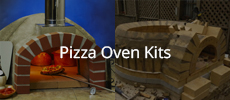David
This is great. Nothing better than real data. While your at it could you add some variations of the lime/grog (firebrick dust)/sand mix? Say 2/1/4 and 1/1/4 just to see how they perform. You probably know it’s important that the lime be the variation that can become hydraulic. Sometimes it becomes confusing.
X
-
It’s an excellent question and I’m therefore going to conduct some tests to see what they show. The degradation of OPC and temperature is not, I believe, a sudden reaction at 300C. I think it’s a bit like the vitrification of clay happens gradually from 573C and makes the clay body stronger as the temperature rises. The difference being relative strength of biscuit fired clay 900C+ and porcelain 1300C. Although in this case it gets stronger as the temperature rises rises not weaker.
I have made up the following mixes to test some stuff.
(mixes by volume)
1. 3:1:1:0.5 graded sand, hydrated lime, OPC, clay
2. 3:1:1:0.5 graded sand, hydrated lime, grog, clay
3. 3:1 graded sand, hydrated lime
4. 3:1 grog, hydrated lime
I will let the samples set and damp cure for a week before testing their strength.
I can also fire some samples up to 500C in my kiln to see what that shows, although this does interrupt a firing schedule, opening the kiln, then refiring at a vulnerable temperature stage, so will see what the strength tests reveal first.
There is also a time factor using the carbonation of lime to create the reaction, that a week of curing may not reveal, maybe it takes months. I think it's something like 3 months.
https://www.buildinglimesforum.org.u...at%2090%20days.
Thanks for sparking my interest in this topic. I think that the homebrew recipe, being around for so long, must have had the testing and tweaking of many variables over the decades (my own included) to arrive at its current formula, so don’t expect miracles.
I think there's a better case for adding some burnout fibres to any type of oven or kiln mortar to reduce the problems of steam spalling. Because of the large variation in thickness of the mortar joints this problem becomes greater.
Last edited by david s; 04-11-2025, 08:26 PM.
Leave a comment:
-
When I say grog I’m referring to firebrick dust from cutting. I’d use it as a mortar. Not castable. I ask because it’s been accepted for so long that homebrew has PC. But what’s the point if it burns off anyway?? Not trying to be difficult. Just asking a provocative question. If you can use firebrick dust/chamotte/grog and it has the same effect as PC but doesn’t burn off then why not??
Leave a comment:
-
I don’t believe it does fail completely it happens gradually and begins to fail north of 300C. You’ve got me interested in its effects now. I will make some tests, eliminating the Portland to see what happens.
dust from cutting fire bricks is far finer than grog and will behave in a similar way to powdered clay because of these finer particles. The dust created from crushing firebricks when processing grog, is usually discarded with the remaining particles sieved, removing the larger particles so the particle size is more uniform. Mine is 0.3 to 0.7 mm
Not sure how you intend to use it. Castable or as a mortar?When crushed firebrick is used as a castable aggregate to be mixed with calcium aluminate cement at 5:1, it is recommended to crush and sieve it so anything larger than 6mm is removed as well as discarding the dust. (Kilns by Daniel Rhodes)
Leave a comment:
-
Grog does act as a pozzolan with lime and as such makes it hydraulic and I assume cementious. Hence why the need for PC? The grog I’m collecting is dry from bricks I’m cutting with an iQ dustless saw. Does not use water
Leave a comment:
-
Hi Mike,Originally posted by MikeD55 View PostCouple of questions regarding homebrew
Q1. Has anyone tried using firebrick dust (grog/chamotte) in place of fireclay? It’s my understanding since it’s prefired it doesn’t shrink. I was also told by a restoration mason who specializes in lime that it acts as a pozzolan and reacts with the lime to make it hydraulic. Seems like it would eliminate the need for PC
Q2. Has anyone tried using water glass (sodium silicate) in place of water. Does it react negatively with lime?
Thanks
Mike
Correct, the fired clay doesn’t shrink on setting, but will of course expand and shrink as the other materials in the brew (although at different rates) will. The qualities of clay once mixed with water impart a stickiness to the mix which is an advantage as a castable, but a disadvantage as a mortar. The shrinkage problem has led me to alter the clay content to half. Ie 3:1:1:0.5 If you replace it with grog you will eliminate the shrinkage problem, but lose the stickiness. Grog is not cheap because it has been fired, crushed and processed. Clay is not hydraulic, so either fired or unfired , should be considered as an aggregate. I could be wrong, but not aware that grog can act as a hydraulic in conjunction with lime. I wouldn’t be eliminating the PC. The idea is that it provides the strength at lower temps and when it rises sufficiently to start breaking down the PC (300C+) the lime takes over. If the lime starts to fail (500C+) then the clay begins to vitrify taking over as the “glue”. This is why the homebrew is so rich in hydraulic content. I think the far smaller particles of the powdered clay would work far better in this regard than the much larger particles of the grog.
Dave
Leave a comment:
-
Yes i am pretty sure you can do that. Just be a matter of collecting enough and drying it out. I am N pretty sure people have done that i. The past.
Leave a comment:
-
Homebrew
Couple of questions regarding homebrew
Q1. Has anyone tried using firebrick dust (grog/chamotte) in place of fireclay? It’s my understanding since it’s prefired it doesn’t shrink. I was also told by a restoration mason who specializes in lime that it acts as a pozzolan and reacts with the lime to make it hydraulic. Seems like it would eliminate the need for PC
Q2. Has anyone tried using water glass (sodium silicate) in place of water. Does it react negatively with lime?
Thanks
MikeTags: None





Leave a comment: